The National Museum of the Philippines is a museum of the Filipino people. It houses the most important ethnographic, anthropological, archaeological and visual artistry of the Philippines from the prehistoric period to the modern times.
If you are visiting Manila, the capital city of the Philippines, the National Museum is a place you must not miss. If you live in Metro Manila, and you’re always passing through Padre Burgos Avenue and Rizal Park, I assume you have already toured the different galleries inside the National Museum.
But if in case you haven’t, here are 15 photos that will make you eager to visit the National Museum of the Philippines right now.
1. How could you miss this architectural beauty located in the heart of Manila?

The National Museum of the Philippines is located in Padre Burgos Avenue, Rizal Park, Ermita, Manila. It’s a few minutes walk from the LRT-1 United Nations Station. It’s open on Tuesdays-Sundays, 10:00 AM – 5:00 PM. Entrance fee is only P150 pesos for adults from Tuesday to Saturday, and it’s free on Sundays! So what are you waiting for?
2. Don’t you like to see the Manunggul Jar which was made before Christ was born?

The Manunggul jar is one of the most precious jar collections of the Philippines. It is a secondary burial vessel excavated from a Neolithic burial site in Manunggul cave of Lipuun, Palawan dating back from 890-710 B.C. If you’re familiar with the 1991 edition of 1,000 peso bill (the one with the Banaue Rice Terraces), you’ll remember those two prominent figures at the top handle of the jar.
3. How about looking face to face with these prehistoric artifacts?

The National Museum has a gallery called “The Origin (Pinagmulan)”. The gallery presents vital information about the Philippines and the Filipino people during the four periods of Philippine pre-history: Paleolithic, Neolithic, Metal, and Ceramic Age.
4. Have you heard about the treasures of San Diego?
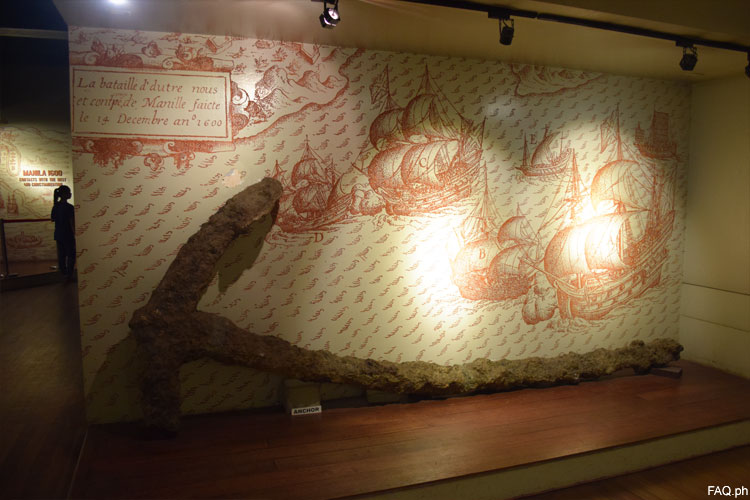
The anchor above is from the Galleon San Diego. The Spanish battleship sank just off Manila Bay when it clashed with the Dutch Ship Mauritius on December 14, 1600. When the shipwreck was discovered by French underwater archaeologist Franck Goddio in 1992, more than 34,000 artifacts and ecofacts were recovered from the site, including Chinese porcelains, Portuguese cannons, Japanese katanas and Mexican coins.
5. Why there were Japanese Katanas in the Spanish warship San Diego?
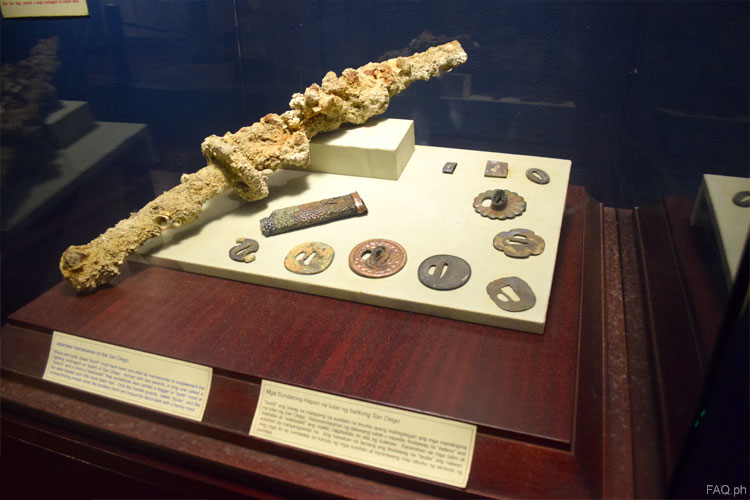
The artifacts above belonged to the Japanese mercenaries recruited by the Spaniards to supplement the fighting contingent on board the San Diego.
6. Travel back in time with this Balangay or Butuan boat.
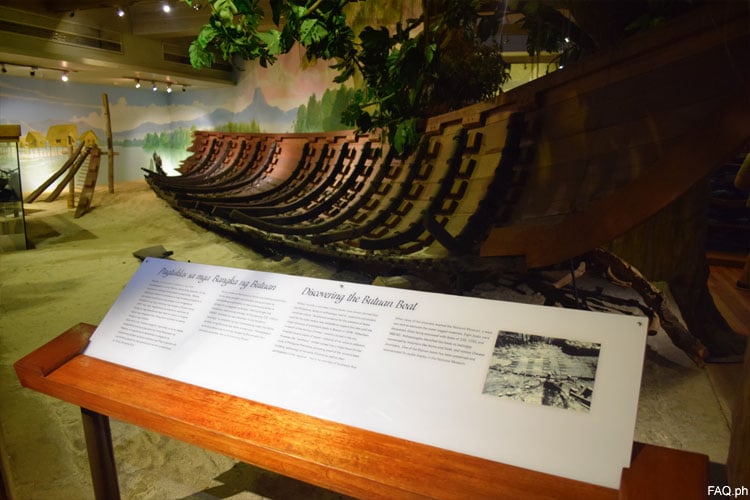
This is a Butuan boat dated back to 1250 A.D. The boat is displayed at the Pinagmulan Gallery (The Origin), in the 2nd floor of the National Museum. It is the second boat recovered among the nine existing prehistoric boats in the Philippines. The first boat dated 320 A.D. is in the site museum in Libertad, Butuan. The Balangay or Butuan boat is an evidence of early Filipino craftsmanship and their seamanship skills during pre-colonial times.
7. Do you know these national cultural treasures?
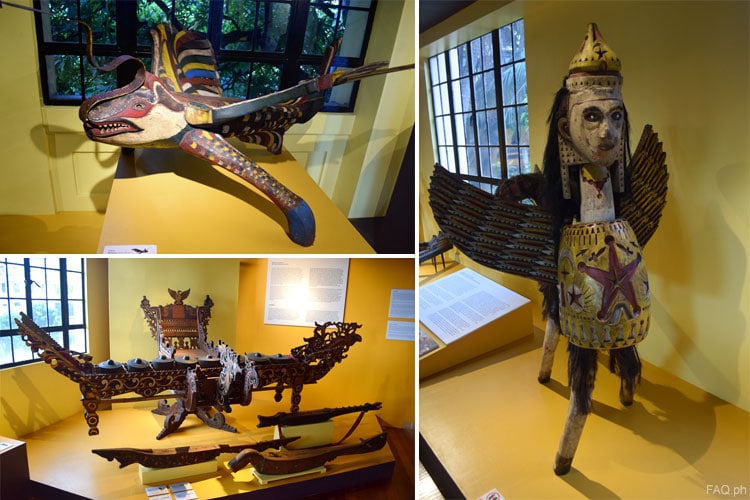
Perhaps you are familiar with the figures above, as you might have seen them already in Philippine textbooks or postcards. In the picture from the right are the “Borak” (a mythical figure with the body of a horse and the head of a man), “Kokora” (a coconut grater used by the Maranao), and the famous “Kulintangan” (a musical instrument composed of a row of small, horizontally laid gongs).
8. Have you seen the works of master Filipino sculptor Isabelo L. Tampinco?
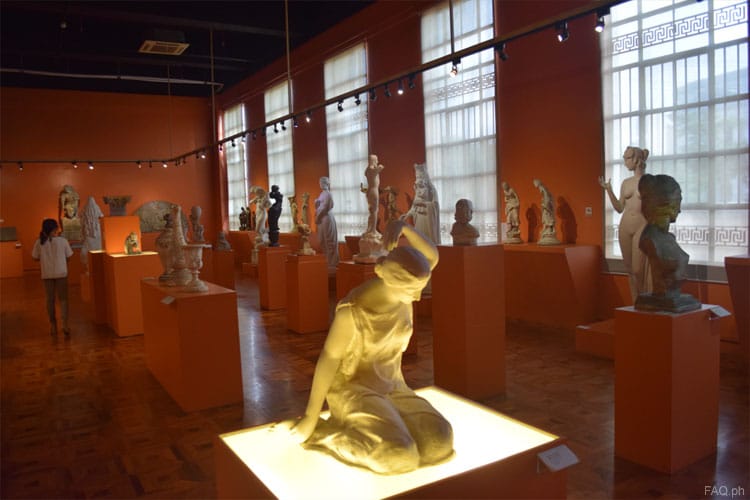
If Juan Luna is for painting, Isabelo L. Tampinco is for sculpture. Filipino sculptor Isabelo L. Tampinco (1850-1933), a contemporary of Jose Rizal, was known for developing the Estilo Tampinco style of carving and ornamentation. Most of his works were destroyed during World War II. However, you can still see some of his remaining works at the Fundacion Santiago Hall in the National Museum.
9. Here’s an altar piece from one of the oldest churches in Bohol.
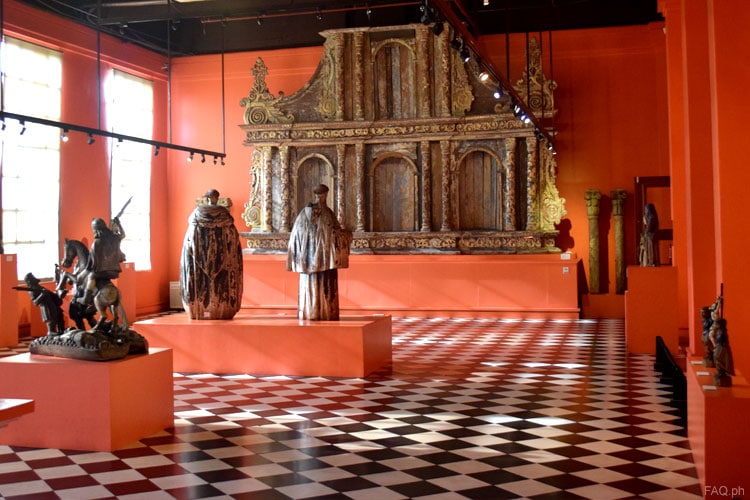
The gallery I (Luis I. Ablaza Hall) of the National Museum features various religious arts from the 17th to 19th centuries, including a National Cultural Treasure, a retablo (altar piece) from the Church of San Nicolas de Tolentino in Dimiao, Bohol.
10. Who would not want to see the works of National Artist Guillermo E. Tolentino?

The works of National Artist Guillermo E. Tolentino, who dominated Filipino sculpture in the 1920s to 1970s, are displayed at Gallery XII (Security Bank Hall) in the National Museum. Tolentino was also the sculptor of the Bonifacio Monument in Caloocan City and the Oblation statue of the University of the Philippines.
Related article: 12 Famous Monuments and Shrines in the Philippines that You should Visit
11. Here are pencil and ink sketches drawn by the first National Artist of the Philippines.
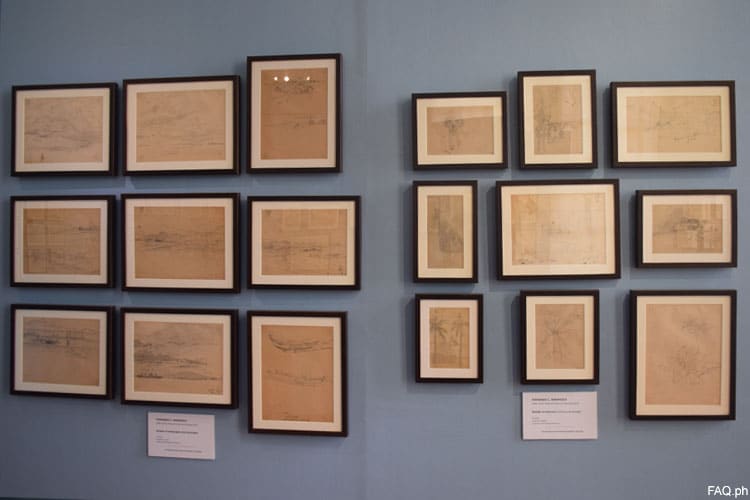
Fernando C. Amorsolo (1892-1972) was the first National Artist of the Philippines. He was known for his oil paintings of rural life made in the classical style. The Gallery XI (SSPC Hall) displays the drawings of Amorsolo. It contains over 100 drawings made in a series of black-and-white pencil and ink sketches prior to making his final artwork.
12. You will surely love these cubist paintings by Vicente S. Manansala.
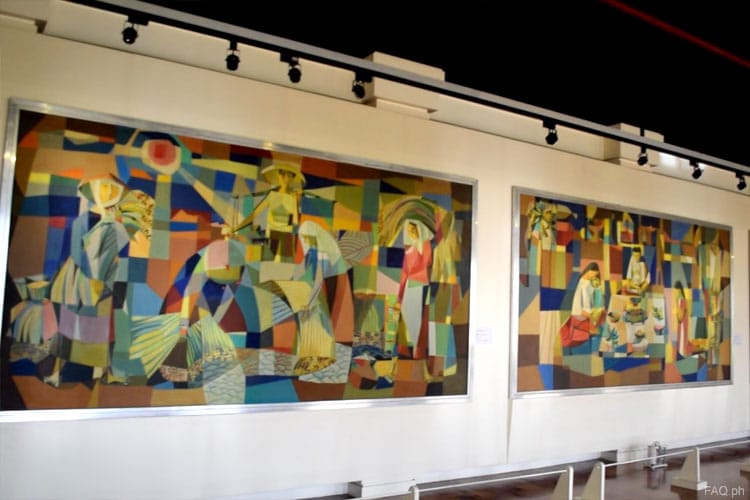
The Philippine-American General Life Insurance Company (Philam Life) commissioned Vicente S. Manansala in the 1960s to create seven large paintings for its building in U.N. Avenue, Ermita, Manila. This collection of amazing cubist paintings are now displayed at Gallery XXV (Philam Life Hall) in the National Museum of the Philippines.
13. Would you like to see more paintings and portrait busts of Jose Rizal?

At Gallery V of the National Museum is a homage to Dr. Jose Rizal, a Filipino National Hero, patriot, novelist and poet. The gallery honors Rizal, who was also a skilled artist. A visit to the gallery will give you an opportunity to see his drawing of the view of Gendarmenmarkt from his 1886 visit to Berlin, his sculptures Bust of Ricardo Carnicero, San Pablo Ermitano, Oyang Dapitana, and Mother’s Revenge, a declared National Cultural Treasure.
Related article: 25 Facts You Should Know About Rizal Monument and Luneta Park
14. How about roaming around the old Senate Session Hall of the Philippines?
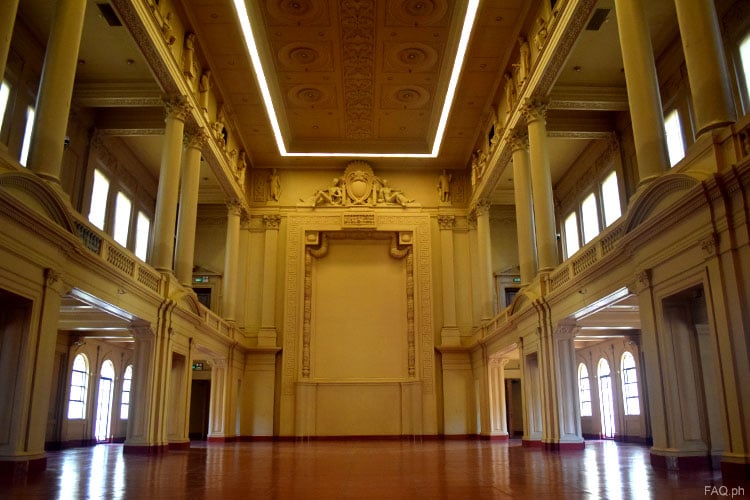
This Hall was originally designed by Architect Ralph Harrington Doane and Antonio Toledo in 1918 to be a library. However, architect Juan Arellano revised the original plans in order to convert the building to the seat of the legislature. The Second Regular Session of the 7th Philippine Legislature was formally opened during its inauguration on July 16, 1926 in the presence of Governor-General Leonard Wood, then Senate President Manuel L. Quezon, and House Speaker Manuel Roxas. You can also see more classical works of Filipino sculptor Isabelo Tampinco in the ornamentation and decoration of the Hall.
15. And of course, don’t you want to have a souvenir picture with the Spoliarium?
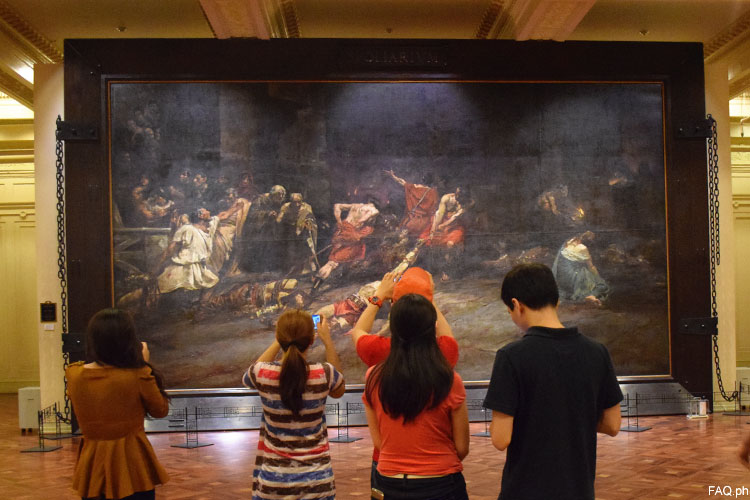
The Spoliarium by Juan Luna Y Novicio is one of the most famous and precious paintings in the Philippines. At 4.22 meters x 7.675 meters dimension, it is also the largest painting in the country. The painting was made by Luna in 1884 as an entry to the prestigious Exposicion de Bellas Artes (Madrid Art Exposition, May 1884) where it won the First Gold Medal. The painting is displayed across El Asesinato del Gobernador Bustamante (The Assassination of Governor Bustamante) painting by Félix Resurrección Hidalgo at the Old House of Representatives Session Hall in National Museum.
There are still thousands of other National treasures displayed in the National Museum that await you.
So what are you waiting for?
The National Museum is open Tuesdays to Sundays, from 10:00 AM to 5:00 PM. The admission is free every Sunday. Entrance Fees to the Museum are as follows:
Entrance Fees to the Museum of the Filipino People and National Art Gallery
(also includes visit to exhibits of the National Planetarium.)
For individual (in PHP):
Student: 50.00
Senior Citizen: 120.00
Adult: 150.00
For groups of 51 or more (in PHP)
Students: 40.00
Adult/Senior Citizen: 120.00
The entrance fees for the following are waived (with valid ID):
A. One faculty member for every group of 30 students
B. One tour coordinator per scheduled museum tour
C. Museum workers with I.D.s
D. National Museum staff and their immediate family
For inquiries call:
Museum Education Division
Telefax #: 527 0278
Email: education@nationalmuseum.gov.ph
Look for Lina/Tess
For reference and more information, visit the official website of the National Museum of the Philippines.
About Rig Man
Rig Man is a Filipino nationalist. He loves to travel through space and time – through astronomy, history and geology.
Suggestion ko yung Senate session hall sana ilagay yung original (or replica) nung mga seats at table na ginamit ng mga senators noon. Tapos maglagay ng mga full-size wax figures ng mga dating senators dito
Good suggestion!